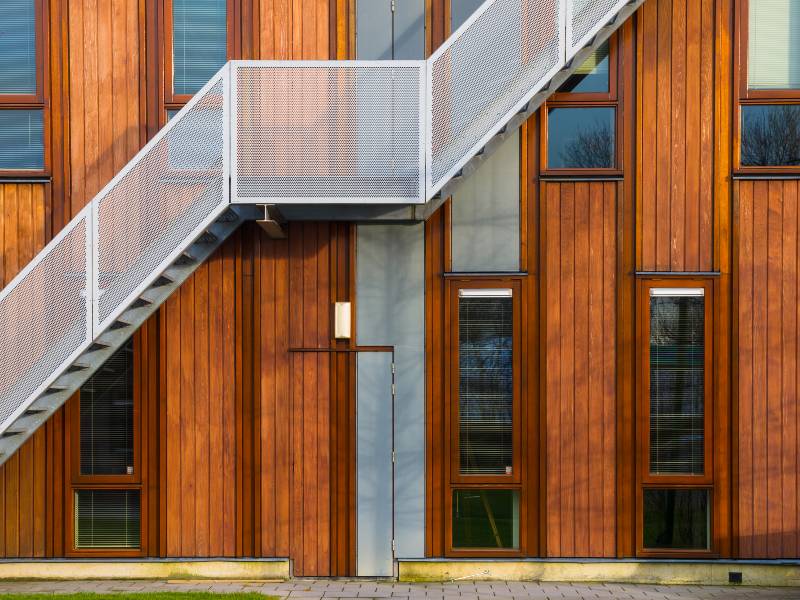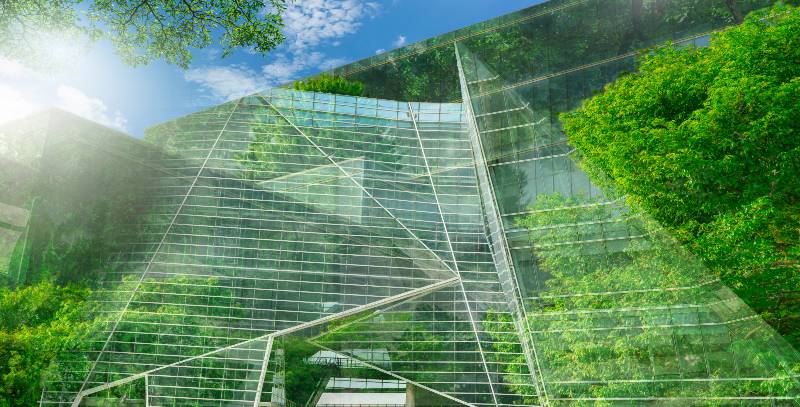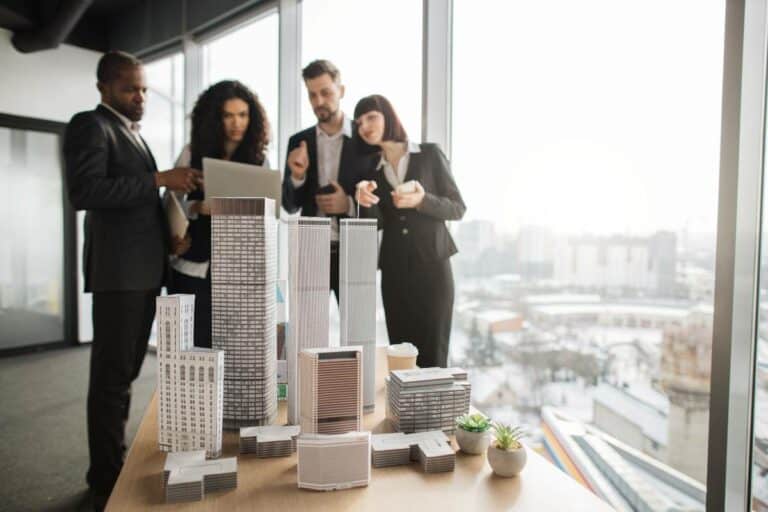Do you manage a commercial property? In today’s world of heightened environmental awareness, sustainable building practices can help you reduce costs and ensure that your facility is reputable. Sustainable practices don’t just mean good PR for your property—they also represent savings in water use, energy efficiency, and long-term maintenance costs.
Yet managing green buildings or commercial space comes with its challenges: understanding the complexities of local policies, finding reliable funding opportunities, and even learning how to motivate staff to be engaged in efforts towards sustainability. That’s why I’ve put together this comprehensive guide to help you make informed decisions when it comes to implementing sound green strategies into your real estate venture.
The percentage of American businesses that have implemented formal green programs witnessed an increase of 54% last year as per the latest research from Buck Consultants via Techcrunch.
Key Takeaways
- Lighting upgrades, HVAC system optimization, building automation systems, and energy audits can improve energy efficiency in commercial properties.
- Recycling programs, composting programs, sustainable building materials procurement, and construction and demolition waste management can reduce waste and promote sustainability in commercial properties.
- Low-flow plumbing fixtures, rainwater harvesting, xeriscaping, and irrigation system upgrades can help conserve water in commercial properties.

Energy Efficiency
Lighting Upgrades
Sustainable practices for commercial property management are becoming increasingly important in today’s world. Adopting energy-efficient strategies not only helps the environment but saves money in the long run. One simple upgrade that can make a big difference is lighting. Switching to LED lights and adding motion sensors can result in up to 90% energy savings. Plus, LED lights last much longer than traditional bulbs, which means fewer replacements and less waste.
HVAC System Optimization
Optimizing HVAC systems should be a priority for improving energy efficiency in both the environment and commercial buildings, especially after addressing lighting improvements and other easily achievable changes, since HVAC systems typically use 44% of a building’s energy.
Optimizing a building’s HVAC system can have several benefits, including reducing energy usage and costs by 20 to 40%, improving equipment reliability by operating more efficiently at optimal temperatures, maintaining healthy air quality and building comfort consistently, and reducing the building’s carbon footprint.
The term “optimization” is frequently used in the HVAC industry to describe different kinds of controls and upgrades. However, achieving optimal HVAC performance entails using an automated system to control HVAC equipment as a complete system, 24/7, in order to minimize energy consumption without compromising building performance.
For optimal efficiency and performance, the chillers, boilers, air handling units, ductwork, diffusers, thermostats, sensors, and other components must work together seamlessly. Additionally, optimization software should gather and analyze data from the system to identify further opportunities to enhance efficiency and provide performance metrics.
Although optimization can be a substantial project, it is worthwhile to undertake it due to the immediate savings it provides and the typical payback period of fewer than four years.
Building Automation Systems
A BAS (building automation system) enables an operator to manage and keep an eye on all the building systems that are connected, using a single interface. Using electronic devices that are connected to a network, BAS technology provides centralized control over your building’s systems.
Before, it was hard to adjust HVAC, lighting, power, and access control systems because it required a lot of manual work. But now, building automation solutions make it possible to combine these systems and manage them all from one place. This makes it easier to make decisions and saves time.
Automated building operations can decrease facilities management costs by regulating the operation of building features such as HVAC and lighting. This leads to reduced energy consumption, which helps create an environmentally sustainable building that can become green-certified.
Some buildings can save up to 30% on energy costs by implementing automation.
Automated Building Systems (BAS) help to reduce overall energy usage, leading to a range of environmental benefits and promoting better health and happiness for building occupants. The advantages of automation include cost savings from lower energy usage and reduced waste. Moreover, automation significantly minimizes a building’s stress on the electrical grid.
Energy Audits
If companies and organizations want to reach Net Zero emissions, they should conduct energy audits to identify areas where they waste and inefficiently use energy. Energy auditors can review energy bills and usage data, examine the physical structure and systems of the building, and analyze operational practices to provide suggestions on reducing energy consumption and costs while also lowering carbon emissions.
Water Conservation
Low-Flow Plumbing Fixtures
Installing low-flow fixtures is an eco-friendly and sustainable option for remodeling or new construction. Faucet aerators, low-flush toilets, and showerheads are some examples of low-flow fixtures that can significantly reduce water bills. The federal government established national standards for the flow rate of plumbing fixtures through the U.S. Energy Policy Act of 1992. These standards are regularly updated to ensure water conservation and sustainability objectives are met.
Rainwater Harvesting
Clean water supplies across large areas of the world are under major strain, and there are now serious concerns about significant water shortages.
This is happening due to various reasons, with the main ones being: more people living in cities and relying on water sources far away; individuals using a lot of water each day (up to 150 liters per person); and the effects of climate change. We urgently need to prioritize sustainable water services and reconsider how we use water.
To address this, several places are implementing comprehensive methods for managing water in urban areas. These strategies are part of a broader approach to managing the entire hydrological cycle in these areas. One primary element of integrated water management is rainwater harvesting. This method can help lessen the burden on public water utilities and infrastructure and make cities more resilient to the impacts of climate change.
Xeriscaping
Xeriscaping involves designing landscapes that require minimal or no irrigation by utilizing the natural climate. Hence, such landscapes are ideal for reducing the need for watering.
In dry regions of the western United States, Xeriscaping has gained popularity due to prolonged droughts and the need to conserve water. Denver, Colorado was among the first urban areas to promote xeriscaping, as the city’s water department urged residents to reduce their use of drinkable water on lawns and gardens.
Xeriscaping is a popular method in some regions due to its benefits for the environment and finances. Choosing plants that are suitable for the local climate is the most crucial environmental factor in xeriscaping. Drought-tolerant plants, which require minimal irrigation, are the most suitable for this landscaping method. It involves removing grass lawns and replacing them with drought-tolerant native plant species, as well as soil, rocks, and mulch. This landscaping technique may also feature trees like myrtles and flowers like daffodils, both of which require less water.
Xerophytes are plants that have specially adapted to arid climates. In Phoenix, Arizona’s desert areas, gardeners make use of xeriscaping to plant native plants like ocotillo.
According to advocates of xeriscaping, it can lower water consumption by 50 or 75 percent, resulting in water and cost savings. As an example, residents in Novato, California were given conservation incentives such as reduced water bills to switch from regular lawns to xeriscaping. The city’s water department approximated that households and companies that made the switch can save money, save energy, and even save around 120 gallons of water every day.
Irrigation System Upgrades
The Green Revolution has been significantly aided by irrigation, which has led to improved agricultural production on a global scale. This increase in production has resulted in numerous benefits, including improved food security, greater livelihoods, and decreased poverty. Although irrigated agriculture only covers around 21% of cultivated land, it actually produces approximately 40% of the world’s total crop output. As a result, many governments still consider irrigation to be a crucial factor in promoting food security and rural development. Investing in irrigation is often seen as a practical way to adapt to the effects of climate change.
Materials and Waste Management
Recycling Programs
As we all become more aware of the impact our actions have on the environment, it’s important for commercial property managers to implement sustainable practices that reduce waste and promote the efficient use of resources. One practical way to do this is through an effective materials and waste management plan. This includes recycling programs that separate paper, plastics, and other recyclable items from general waste. Not only does this help reduce the amount of waste sent to landfills, but it also has the potential to save property owners money and boost their eco-friendly credentials.
Composting Programs
When it comes to commercial property management, sustainable practices should always be top of mind. One area where this is especially important is in materials and waste management. By implementing effective waste reduction strategies, businesses can significantly reduce their environmental impact and reduce costs. Composting programs, in particular, are an excellent way to turn food and other organic waste into nutrient-rich soil that can be used on landscaping and other green areas. These programs not only help reduce waste but also provide a valuable resource for the property.
Construction and Demolition Waste Management
As commercial property management becomes increasingly focused on sustainability, one key area of concern is materials and waste management. From construction and demolition waste to ongoing waste generated by tenants and visitors, there are numerous opportunities to reduce waste and make better use of materials. Responsible waste management practices can not only help reduce environmental impact but also lower costs and improve overall efficiency.
Procurement of Sustainable Building Materials
Sustainable practices have never been more important in commercial property management than they are today. One area where businesses can have a great impact on the environment is through the materials they use and the waste they produce. By implementing sound materials and waste management systems, such as recycling programs and composting efforts, commercial properties can significantly reduce their environmental footprint.
Additionally, the procurement of sustainable building materials can also make a tremendous difference. Choosing products made from renewable materials and utilizing environmentally-friendly manufacturing processes not only benefits the environment but also promotes healthier indoor air quality for tenants.
Transportation and Mobility
Encouraging Carpooling and Public Transportation
One of the key sustainable practices for commercial property management is to promote transportation and mobility options that reduce single-occupancy vehicle usage. Encouraging carpooling and the use of public transportation are effective ways to reduce carbon emissions and traffic congestion. Property managers can offer incentives to employees who carpool, such as designated parking spots or reduced parking fees. Public transportation can also be promoted by providing schedules and transit maps in common areas and offering subsidies for transit passes.
Installing Electric Vehicle Charging Stations
Commercial property management is a complex and challenging task, but incorporating sustainable practices can help make it more manageable. One of the areas that can have a significant impact on your property’s sustainability is transportation and mobility. You can take a step towards promoting green transportation by installing electric vehicle charging stations on your property. This will not only attract eco-conscious tenants but also provide a sustainable mode of transportation to your employees and visitors.
Promoting Active Transportation
As commercial property managers, it is important to consider sustainable practices that promote the reduction of our carbon footprint. One way to do this is by promoting active transportation. Encouraging tenants and employees to utilize sustainable forms of transportation such as biking, walking, or public transit can have a significant impact on the environment. In addition to the environmental benefits, promoting active transportation can also lead to a healthier lifestyle for individuals and a sense of community within the office.
Developing Sustainable Transportation Plans
The impacts of commuting, business travel, and supply chain logistics are not only felt in the environment but are also reflected in operating costs. That’s why developing a sustainable transportation plan is crucial for property managers looking to make a positive impact. This plan should include alternative transportation options, such as biking or carpooling, as well as implementing electric vehicle charging stations and optimizing supply chain logistics for maximum efficiency.
If you’re interested in more sustainable practices and looking for tips, we have just the article for you! Check out this great read on how the power of green initiatives is reshaping and transforming commercial real estate. It’s amazing what small steps can lead to for our planet, and integrating those steps into business practices is both responsible and forward-thinking. So take a look, and see how you can contribute to creating a greener world!
Sustainable Practices for Commercial Property Management FAQs
What are sustainable practices in commercial property management?
Sustainable practices in commercial property management are gaining traction as more and more companies prioritize eco-friendliness. Property managers are finding new and innovative ways to reduce waste, conserve energy, and minimize their carbon footprint. One example is the implementation of energy-efficient lighting and heating systems. Another is the incorporation of environmentally conscious materials in building construction and maintenance. By adopting these practices, not only do property managers contribute to a healthier planet, but they can also attract more tenants who value sustainability.
Why are sustainable practices important for commercial properties?
As commercial properties continue to expand and contribute to the growth of various industries, it’s vital to consider the environmental impact of such developments.
The implementation of sustainable practices is essential in this regard, not just for reducing the carbon footprint but also for ensuring long-term benefits.
For one, it helps reduce energy and water consumption, leading to a considerable decrease in utility expenses. In addition, sustainable practices like green landscaping, waste reduction, and the use of eco-friendly materials contribute to improving air quality and reducing pollution levels. More importantly, incorporating sustainable practices can boost a company’s reputation, attracting consumers who value environmentally conscious businesses.
How can energy efficiency be improved in commercial properties?
Improving energy efficiency in commercial properties not only helps the environment but also provides cost savings for business owners. One way to achieve this is by conducting regular energy audits to identify areas that require improvement.
These audits can assess the heating, ventilation, and air conditioning systems, lighting, and equipment to ensure that they are functioning efficiently. Additionally, installing energy-efficient appliances and using natural lighting can significantly reduce energy consumption. Business owners can also educate their employees on energy-saving practices such as turning off lights when not in use and utilizing power-saving modes on computers.
What are some water conservation practices for commercial properties?
As environmental conservation continues to gain importance, more and more commercial property owners are seeking ways to cut down on their water usage. Fortunately, there are numerous practices that businesses can adopt to reduce their water footprint. Some of the most effective water conservation methods for commercial properties include fixing leaks as soon as they are detected, installing low-flow faucets, urinals, and toilets, using drought-tolerant landscaping, and reusing gray water.
How can materials and waste be managed sustainably in commercial properties?
If your commercial business generates a significant amount of raw material waste, you can start a composting program. But ensure that you place to compost and recycling bins consistently in the same location and with the same color throughout the property. Recycling helps prevent tons of waste materials from ending up in landfills each year.
Conclusion
Sustainable practices for a property management company can provide incredible benefits for both the property owner and the environment. Easy-to-implement techniques, such as using building automation systems, energy audits, and water conservation, offer simple and cost-effective ways to reduce your overall carbon footprint while saving money in the long run.
Additionally, materials and waste management initiatives such as low-flow plumbing fixtures and recycling programs can help support sustainable efforts over time. Transportation planning practices such as carpooling or using public transit also contribute to a sustainable and responsible lifestyle.
Overall, incorporating sustainable practices into commercial property management routines is essential in creating better efficient buildings and happier residents and customers! If you’re looking to start implementing some of these sustainable strategies in your own commercial space, don’t hesitate to call or schedule a free consultation today! I’d be glad to talk and help you out.
Blog Articles Disclaimer
The information presented in articles on our website or affiliated platforms is exclusively intended for informational purposes. It’s crucial to grasp that this content does not constitute professional advice or services. We strongly recommend our readers to seek guidance from appropriately qualified experts, including, but not limited to, real estate and other attorneys, accountants, financial planners, bankers, mortgage professionals, architects, government officials, engineers, and related professionals. These experts can offer personalized counsel tailored to the specific nuances of your individual circumstances. Relying on the content without consulting the relevant experts may hinder informed decision-making. Consequently, neither Tolj Commercial Real Estate nor its agents assume any responsibility for potential consequences that may arise from such action.






